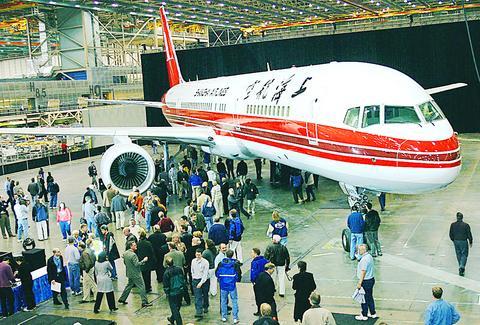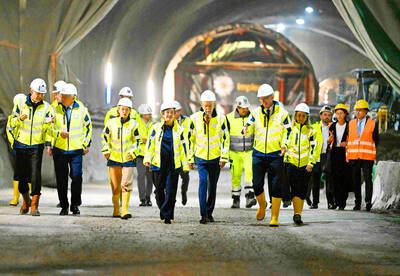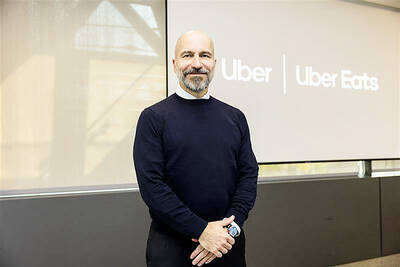The Boeing Co has closed out the 757 commercial jet program with the last of the 1,050 jets to roll off the assembly line.
T-shirts showing a 757 with the words, "Celebrate the Legacy," were worn by thousands of past and present Boeing workers on Thursday at a ceremony marking the end of two decades of production of the 200-passenger plane in this Seattle suburb.

PHOTO: EPA
"A big chunk of my life has been spent on this program," said Clyde Brown, who worked on the 757 line from the start more than 22 years ago to the end. "That plane has been good to me."
The last 757 is scheduled for delivery to Shanghai Airlines in April.
Brown and many other workers will now work on another plane that figured in the demise of the 757 -- the newest models of the 737, also made in Renton. No layoffs from the end of 757 production are planned.
Alan Mulally, head of the company's commercial airplane division, said Boeing plans to "crank up" 737 production but gave no details.
Boeing, based in Chicago, announced in July that after cutting more than 27,000 jobs in three years, about 3,000 workers will be hired in the Puget Sound region by Dec. 31.
Many are in technical and engineering jobs for the 7E7 program in Everett and a military program to equip the 737 airframe as a Navy submarine-hunting aircraft.
Any new hires for 737 production were factored into Boeing's employment forecast in July, a spokeswoman said.
Mulally was an engineer on the original design team for the 757 program, which was headed by Philip Condit, who went on to become chief executive of Boeing but resigned earlier this year in an uproar over the use of dubious methods to win government contracts.
At the ceremony Mulally noted that all but 20 of the 757s remain in service worldwide.
"It has one of the great safety records of any plane in the world," he said.
One unique feature for Boeing was simultaneous design of the single-aisle 757 and the widebody 767, which is assembled in Everett.
Despite differences in size and range, they were designed with common flight decks so pilots trained on one could fly the other with little additional training, resulting in big cost savings for airlines.
Sales of 757s reached a peak of 99 planes in 1992 but declined to 45 by 2000, then plummeted in the airline industry slump that followed the terrorist attacks of Sept. 11, 2001.
Two of the three planes seized by the terrorists were 757s. One hit the Pentagon and the other crashed into a field in Pennsylvania after passengers stormed the cockpit.
Factors in the end of the line for the 757 include development of bigger, more economical and longer-range 737 models, the 7E7 Dreamliner that Boeing plans to begin building in 2006 and competition from Airbus SAS.
Still, Mulally said predicted that Boeing would be providing product support for the 757 for "the next 30 to 40 years."

CHIP RACE: Three years of overbroad export controls drove foreign competitors to pursue their own AI chips, and ‘cost US taxpayers billions of dollars,’ Nvidia said China has figured out the US strategy for allowing it to buy Nvidia Corp’s H200s and is rejecting the artificial intelligence (AI) chip in favor of domestically developed semiconductors, White House AI adviser David Sacks said, citing news reports. US President Donald Trump on Monday said that he would allow shipments of Nvidia’s H200 chips to China, part of an administration effort backed by Sacks to challenge Chinese tech champions such as Huawei Technologies Co (華為) by bringing US competition to their home market. On Friday, Sacks signaled that he was uncertain about whether that approach would work. “They’re rejecting our chips,” Sacks

NATIONAL SECURITY: Intel’s testing of ACM tools despite US government control ‘highlights egregious gaps in US technology protection policies,’ a former official said Chipmaker Intel Corp has tested chipmaking tools this year from a toolmaker with deep roots in China and two overseas units that were targeted by US sanctions, according to two sources with direct knowledge of the matter. Intel, which fended off calls for its CEO’s resignation from US President Donald Trump in August over his alleged ties to China, got the tools from ACM Research Inc, a Fremont, California-based producer of chipmaking equipment. Two of ACM’s units, based in Shanghai and South Korea, were among a number of firms barred last year from receiving US technology over claims they have

It is challenging to build infrastructure in much of Europe. Constrained budgets and polarized politics tend to undermine long-term projects, forcing officials to react to emergencies rather than plan for the future. Not in Austria. Today, the country is to officially open its Koralmbahn tunnel, the 5.9 billion euro (US$6.9 billion) centerpiece of a groundbreaking new railway that will eventually run from Poland’s Baltic coast to the Adriatic Sea, transforming travel within Austria and positioning the Alpine nation at the forefront of logistics in Europe. “It is Austria’s biggest socio-economic experiment in over a century,” said Eric Kirschner, an economist at Graz-based Joanneum

OPTION: Uber said it could provide higher pay for batch trips, if incentives for batching is not removed entirely, as the latter would force it to pass on the costs to consumers Uber Technologies Inc yesterday warned that proposed restrictions on batching orders and minimum wages could prompt a NT$20 delivery fee increase in Taiwan, as lower efficiency would drive up costs. Uber CEO Dara Khosrowshahi made the remarks yesterday during his visit to Taiwan. He is on a multileg trip to the region, which includes stops in South Korea and Japan. His visit coincided the release last month of the Ministry of Labor’s draft bill on the delivery sector, which aims to safeguard delivery workers’ rights and improve their welfare. The ministry set the minimum pay for local food delivery drivers at